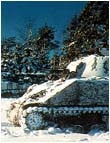|
The 'Spearhead' series is designed to look at the cutting edge of war, dealing with units capable of operating completely independently in the forefront of battle. Each volume in the series examines the chosen unit's origins and history, its organisation and order of battle, its battle history theatre by theatre, its insignia and its markings. Also covered are biographies of the most important commanders of each unit. Each title ends with an assessment of unit effectiveness - as seen by the unit itself, by its opponents and the light of more recent historical research. The books also include a detailed reference section with a critical bibliography, a listing of relevant museums and web sites, information about re-enactment groups and memorials.
The books also include a detailed reference section with a critical biography, a listing of relevant museums and web sites, plus information about re-enactment groups and memorials. ROYAL MARINE COMMANDOS The first British special forces were the Independent Companies sent to Norway to prevent the Germans setting up U-boat bases.
Following the loss of Norway and Churchill's 'butcher and bolt' order of summer 1940, the Army Commandos were developed, including one unit - No 10 - that was raised among our allies, French, Polish, Norwegian, Belgian, Dutch, Yugoslav and - curiously enough - German; the remainder were raised from the field army. The first major operation was the raid on the Lofoten Islands (4 March 1941) but the most important of the Norwegian operations was a small, well-planned attack on Vaagso (27 December 1941), a classic example of a raid. The force destroyed the German garrison and took 102 prisoners - the first time that any quantity of German soldiers had been captured. On top of this a coast defence battery was blown up, about 18,000 tons of shipping and countless fish oil factories were destroyed, all at a cost of 20 killed and 57 wounded. The few raids on Norway in 1941 were enough to induce Hitler and his staff to increase the garrison of that country, so that at the surrender it numbered no less than 300,000 men - all of whom could have been better used elsewhere. Other raids on the coastlines of occupied Europe would take place - including the disaster of Dieppe and the raid on St Nazaire.
The early amphibious raids by the Commandos between 1940 and 1942 pointed up to the obvious need for better intelligence and control on the beaches. So, specialized 'beach parties' were formed and tried during Operation 'Ironclad' to capture the port of Diego Suarez at the northern tip of Madagascar 5/7 May 1942. This proved so successful that the RN Commandos (sometimes known as 'Beachead Commandos') were formed. They took part in all the main amphibious operations from then on - including Dieppe, Torch, Husky, taking the islands of Monte Cristo, and Pantelleria in June 1943, Salemo and Anzlo, the capture of the Island of Elba, landings on the Akran coast, Overlord, the capture of Walcheren and crossing the Rhine at Arnhem.
Elsewhere, Commandos performed with great glory in the desert war and in the Middle East, where Nos 50, 51, and 52 Commandos were raised in 1942 and all Commando units were gathered into four brigades controlled by the Special services (Commando) Group. From then on Commandos took part in all the major amphibious operations in the European theatre - Sicily, Italy and NW Europe - and performed with great distinction. During the D-Day landings Royal Marines manned two-thirds of the landing craft and five RM Commando units also took part. At the end of the war the Army Commandos were disbanded and the commando role was taken on fully by the Royal Marines.
|





